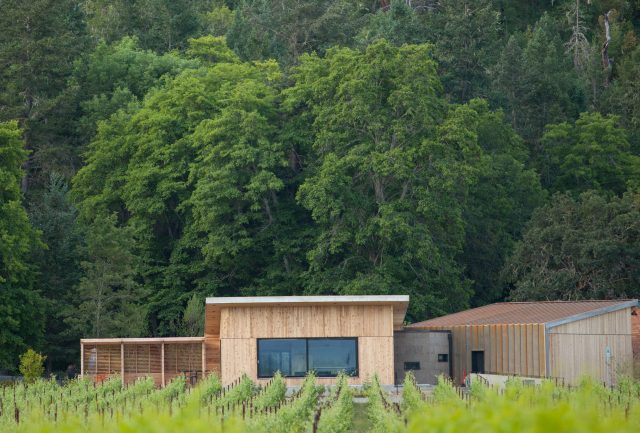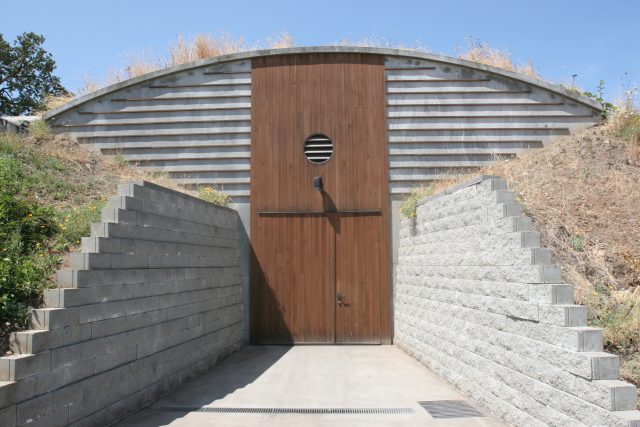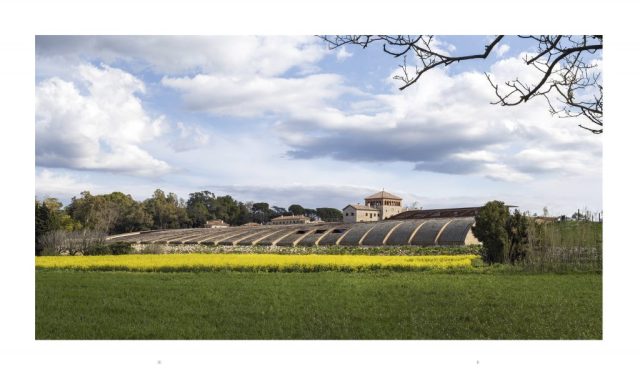This website uses cookies so that we can provide you with the best user experience possible. Cookie information is stored in your browser and performs functions such as recognising you when you return to our website and helping our team to understand which sections of the website you find most interesting and useful.
The wineries drastically reducing the industry’s carbon footprint
The Leadership in Energy and Environment Design (LEED) accreditation is used by some wineries as a way to deliver best-in-class sustainability. So why don’t more know about it? Kathleen Willcox investigates.

Green is the new black. Pop stars, soccer teams—even oil companies—are competing to show the world their eco-friendly receipts. But, too often, when some of the more dubious claims (ahem, big oil) are examined, it seems many millions of dollars are wasted on messaging about eco-friendliness, while legitimate investment in effective low-carbon activities is nil.
Normally, when industries like wine discuss going green, their point of messaging is work in the vineyard. Reducing chemical inputs, investing in electric tractors, reducing reliance on irrigation are all key, obvious messaging points that resonate with wine lovers. Another frequent topic is the carbon footprint of the winery and the production cycle: in this case, solar power, recycling programs and reduced bottle weights are up for discussion.
And while the wine industry is hardly immune to accusations of green-washing, one of the most significant methods of drastically reducing an operation’s footprint is largely being downplayed and ignored: the winery’s structure itself.
The built environment is responsible for about 42% of the world’s annual carbon emissions, according to an analysis from the nonprofit Architecture 2030. The United Nations has warned that carbon emissions from existing buildings, and those in the process of being built, threatens to derail the construction industry’s hope to decarbonise by 2050.
Which is where Leadership in Energy and Environmental Design (LEED) comes in. Created at the dawn of the new millennium, LEED was developed to establish a system of green building with the goal of reducing resource depletion, addressing climate change, and limiting the impact unsustainable construction has on human health and the environment.
Fast-forward two+ decades, and more than 167,000 LEED-accredited buildings have been constructed, resulting in a cavalcade of positive impacts, both major and minor. We look at the rise of LEED accreditation in the wine industry, survey the rapid evolution of green construction—and consider just how much of an impact an eco-friendly building can have on the spirit and purpose of the business itself.
How It Works
LEED, like the construction industry broadly, is in a continual process of transformation as new techniques and technologies allow buildings to become ever-more sustainable. But the framework today is essentially the same as it was when LEED was created.
The latest version is v5, with an emphasis on reducing emission from “operations, materials, construction, refrigerants and transportation, while promoting carbon sequestration and net positive outcomes. Accountability for performance is imperative.”
Buildings earn “points,” on a scale from 40 to 110, with four grades available based on the final project’s overall carbon footprint and sustainability. The highest rating is Platinum (80+), next is Gold (60-79), then Silver (50-59) and Certified (40-49).
Points can be earned for building initiatives that enhance individual human health, protect or enhance biodiversity, protect water resources, utilize sustainable or regenerative materials and enhance community quality of life. About 35% of LEED credits are linked directly to climate change, while 20% are devoted to human health, 15% to water resources, 10% to biodiversity, 10% to the green economy and 5% to community and natural resources.
Laying the Groundwork for Institutional Change
Early adopters of LEED helped lay the groundwork for better building standards that trickle down to the construction industry more broadly. But the process of laying that green foundation, for early adopters, is often arduous.
At Sokol Blosser Winery, which produces between 50,000 and 70,000 cases annually in Dayton, OR, president Alex Sokol Blosser, says that their new barrel cellar, opened in 2002, “only” earned LEED Silver because at that time, “it was the best we could do.”
“Our contractor had never done anything LEED certified at that point, and it was our architect’s second, maybe third LEED project,” Sokol Blosser recalls. “Our learning curve was steep. Just to get Silver we had to recycle 100% of our construction materials like wood and even concrete. To do that, we had to basically create a whole new system of sourcing and recycling construction material in our region, because it didn’t exist.”
Today, he says that 2002 Silver standards are “pretty much standard practice across the industry. As with being B Corp certified and our farming choices, either certified or in-transition organic, we did it because we felt like it was the right thing to do.”
And while there was a slight increase in cost—about 10%, he estimates—over its lifetime, the increased efficiency of the building paid for itself.

At Napa’s CADE and Odette estates, both certified Gold in 2009 and 2017 respectively, managing partner John Conover pursued LEED certification as an ethical imperative.
“Organic farming has always been extremely important to us, and we building in a sustainable manner as part of our larger philosophical approach,” Conover explains. “We were the first to get a Gold certification in California.”
That “first in class” honor comes with a price.
“We were essentially guinea pigs, because we had to create so many processes from scratch,” he says. “We wanted to use green concrete, so we went to our local guy, and he didn’t know what we were talking about.”
Instead of giving up, Conover and his team worked with him to develop a system for creating concrete from one-third recycled materials.
“Now he knows, and now it’s the norm,” Conover says. “We also figured out how to use insulation made from shredded blue jeans. I didn’t think anyone would believe that we had insulation made from ripped up jeans so I replaced a portion of the wall in my office at CADE with glass to show it.”
In addition to using sustainable construction materials, the wineries are also both solar powered and utilize organic farming.
There were so many actionable ah-ha moments during the construction of CADE and Odette, Conover has become an informal consultant for architects and winery owners hoping to build energy-efficient low-carbon wineries themselves.
“I give away all of my secrets,” Conover says. “Not everyone on my staff is thrilled, but I do it because I want other people to do the right thing too. I have a long list of things that were successful, and that just didn’t work. And I’m also happy to discuss how to make it work financially. No one is going to do it if it doesn’t make financial sense—and it can.”
A quiet presence within the landscape
For many producers, LEED certification is part and parcel of a humble, vineyard and community-centric philosophy.
In 2004, the Suqué-Mateau family commissioned RCR Arquitectes to design a new winery at the 13 th century Peralada Castle that anchors the Perelada Winery. But, unlike many other Spanish wineries that have attracted incredible acclaim and visits for their splashy avant-garde designs, the Suqué-Mateau family wanted something visually humble, but environmentally progressive.
“We are located in a medieval town, where the Castle has been the most significant building for centuries,” says Perelada Group’s general manager, Eugeni Llos Norenberg. “We did not want to alter the spirit of the village, or be disrespectful to the history of the place. At the same time, we wanted to create a sustainable building that would drastically reduce energy and water consumption, and respect the biodiversity of the land around it.”

The process was lengthy. The new winery only opened in June of 2022—bookending multiple economic setbacks, the architectural firm winning the Pritzker Prize in 2017 and a pandemic—but Llos Norenberg says it was well worth the wait.
“We visited more than 100 wineries during that time, to understand what other regions and wineries were doing,” Llos Norenberg explains. “For us, we also wanted to create a building that could welcome visitors, but we didn’t want to bring in big groups.
We wanted to find a way to introduce people slowly to our philosophy and way of life, and make it as comfortable as possible.”
The winery, as it stands, is primarily underground, with a small garden and farm that supplies much of the produce to the on-site restaurant.
At Cowhorn Vineyard & Garden in Oregon’s Applegate Valley, a Demeter-certified biodynamic vineyard and farm, co-owner Mini Byers, says that their LEED-certified tasting room reflects the minimal intervention philosophy that informs every decision she makes in the business as a whole. In addition to being LEED-certified, the building has also been Living Building Challenge certified.
“Our vision has always been to be biodynamic, organic and regenerative,” Byers says.
“These certifications require all material to be free from radicals or poisonous materials, and for all combined systems to create a net-zero or net positive footprint for energy and water.”
Byers also focused on making choices that honour and reflect the community around the winery.
“Wherever possible, locally sourced and sustainable materials were used,” she explains.
“Viewing craftsmanship as a form of art, hand-hewn materials such as the walnut table, plaster ceiling and a charred wood bar were selected to celebrate the craftspeople of Oregon.”
An important symbol
LEED certification has become essential for a certain type of winery, advocates argue.
“My peeve is people who say they farm organically, but don’t get certification, or say they build sustainably but don’t get certification,” Sokol Blosser says. “How are consumers supposed to really know if what they’re saying is true? LEED is important because it’s traceable, and the world’s most widely used green building rating system. It has also transformed building codes. It may be dorky to talk about construction, but it is changing the world for the better.”
Conover believes that certifications like LEED will become increasingly important as wineries try to meet the needs and desires of younger generations.
“The way my generation approached judging a wine was by score, price and region,” Conover says. “The way my daughters’ generation approaches it is, ‘how does this align with my values?’ How are they growing their wine and building their winery? LEED is part of a holistic approach to doing business that is important to them.”
For Perelada, the meticulously constructed winery—almost 20 years in the making—has clearly delivered the message it was trying to quietly send.
“Since opening in June of 2022, we’ve had almost 30,000 visitors,” Llos Norenberg says.
“We expected that number over a period of five years. But for us it’s not the volume, it’s the emotional connection. We feel we are communicating who we are in a way that people
from all over the world can instantly understand.”
It’s no easy being—or buying—green. Consider LEED certification another piece of the puzzle when looking for businesses with full-circle sustainability.

